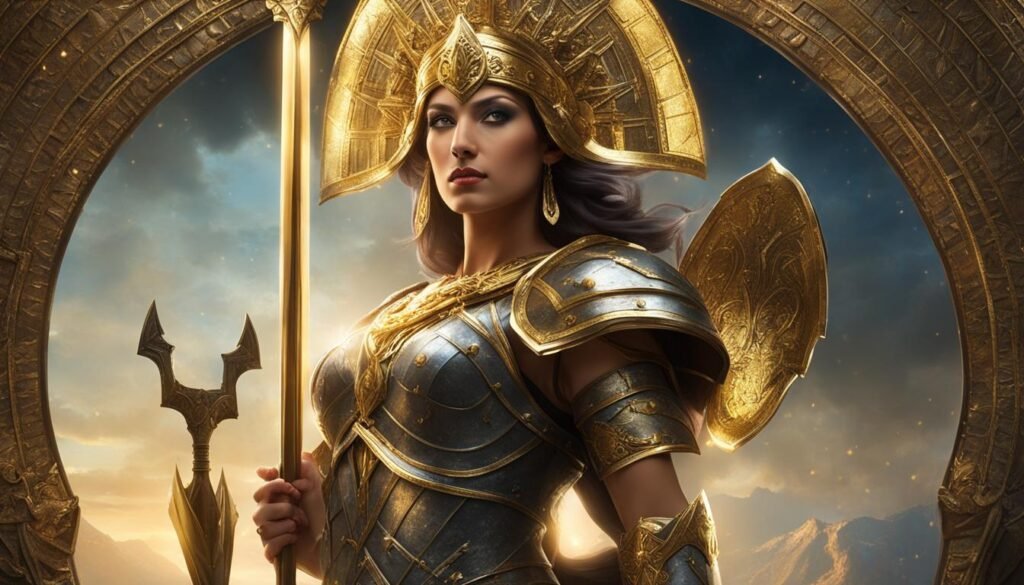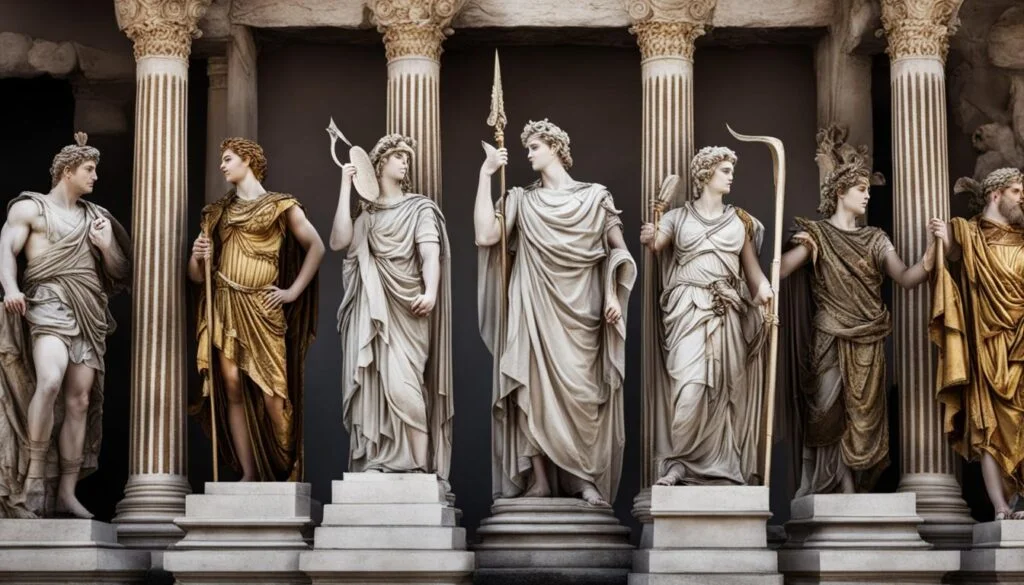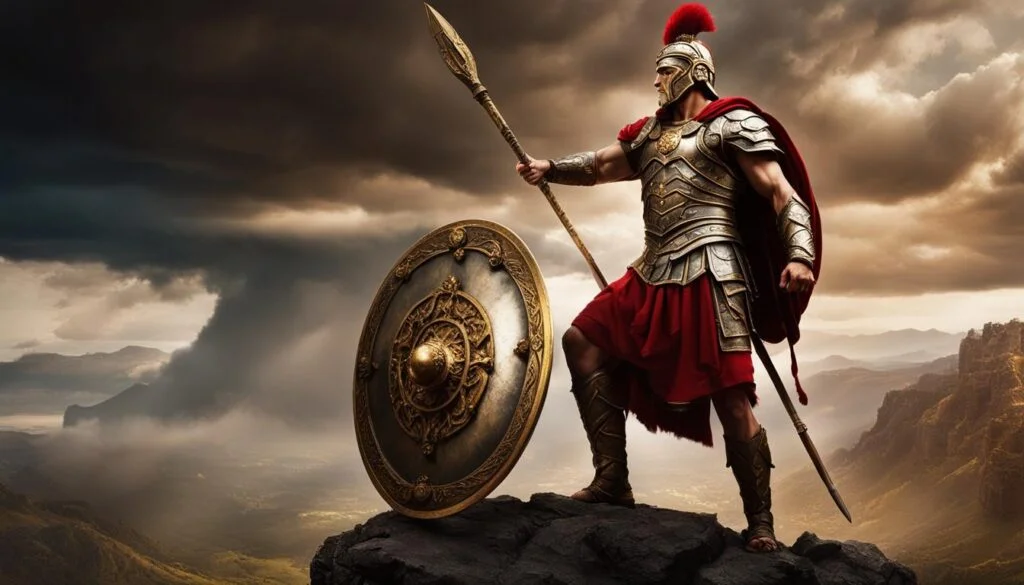Welcome to our exploration of Minerva, the fascinating goddess of Roman mythology. Known for her multifaceted roles in handicrafts, professions, arts, and war, Minerva held great significance in ancient Roman society. Often identified with the Greek goddess Athena, Minerva was a prominent figure in the Capitoline Triad alongside Jupiter and Juno.
Key Takeaways:
- Minerva was an important figure in Roman mythology, associated with handicrafts, professions, arts, and war.
- She was often identified with the Greek goddess Athena and was part of the Capitoline Triad in Rome.
- Minerva’s worship grew, and she became associated with victory and war during the reign of Emperor Domitian.
- She symbolized wisdom, intelligence, and military strategy, representing the progressiveness of Roman society.
- Minerva had various temples throughout the Roman Empire and played a significant role in festivals.
The Origins of Minerva
Minerva, a prominent figure in Roman mythology, has its roots in the ancient religion of Etruria. Believed to have been brought to Rome from Etruria, Minerva shares striking similarities with the Etruscan goddess Menrva. As the daughter of Jupiter, the king of the gods, Minerva has a fascinating birth story.
According to mythological accounts, Minerva emerged fully grown and completely armored from Jupiter’s head. This unique birth emphasized her association with intelligence, strategy, and warfare. Known for her chastity and wisdom, Minerva rejected the advances of Mars, the god of war, cementing her status as a powerful and independent deity.
The importance of Minerva in Roman religion cannot be overstated. She became a revered figure, celebrated for her ability to provide wisdom, inspire intelligence, and offer military guidance. Minerva’s role extended beyond her association with war; she also embraced the domains of handicrafts, arts, and professions.
Through her wisdom, intelligence, and military prowess, Minerva became an influential figure in Roman mythology, earning the admiration and devotion of many. Her cult grew in Rome, and numerous temples were erected in her honor across the Roman Empire.
Minerva’s Symbolism and Importance
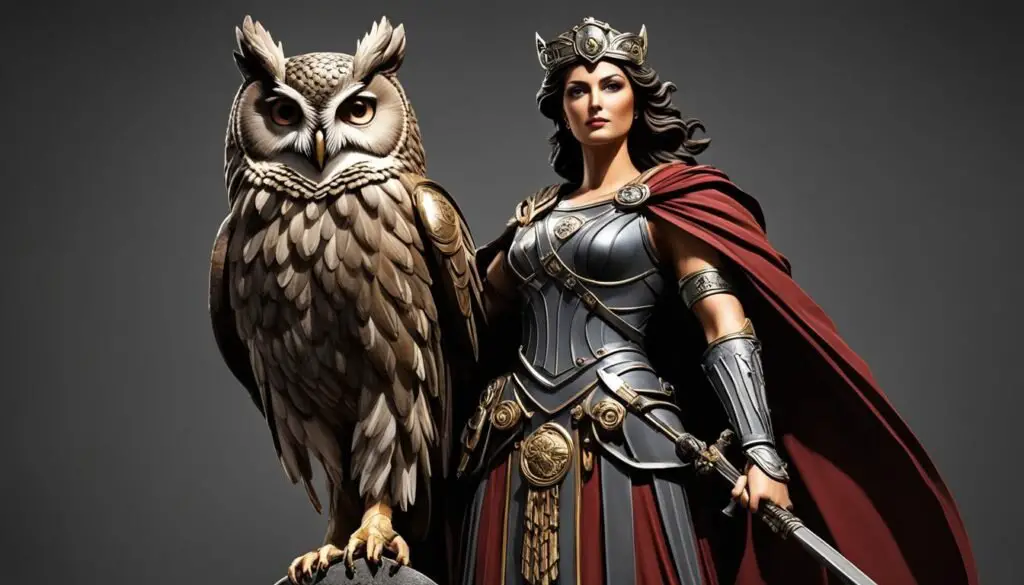
Minerva, the Roman goddess of wisdom, held great significance in ancient Rome. She was highly respected and revered for her role as the embodiment of intellectual pursuits, cleverness, and strategic acumen. As a female deity excelling in traditionally male-dominated fields, Minerva symbolized the progressiveness and inclusivity of Roman society.
Minerva’s association with wisdom made her an essential figure in ancient Rome’s cultural and religious life. She represented the pursuit of knowledge, the power of intellect, and the importance of strategic thinking. People sought her guidance and blessings for endeavors requiring wisdom and ingenuity.
As a testament to her importance, Minerva had numerous temples across the Roman Empire. These temples served as places of worship and celebration, where her followers paid homage and sought inspiration. Her influence extended beyond religious ceremonies, reaching festivals that celebrated art, crafts, and military strategy.
One such festival associated with Minerva was the Quinquatrus, which marked the beginning of the campaign season for the Roman army. During this festival, Minerva was honored for her role in military strategy and intellectual prowess.
However, with the rise of Christianity in the 4th century AD, the worship of Minerva declined. The spread of Christianity led to a shift in religious beliefs and practices, resulting in the fading influence of Roman deities like Minerva. Despite this decline, Minerva’s legacy as a prominent figure in ancient Roman mythology and her symbolism of wisdom and progressiveness continue to captivate the imagination of scholars and individuals interested in ancient civilizations.
The Birth of Minerva
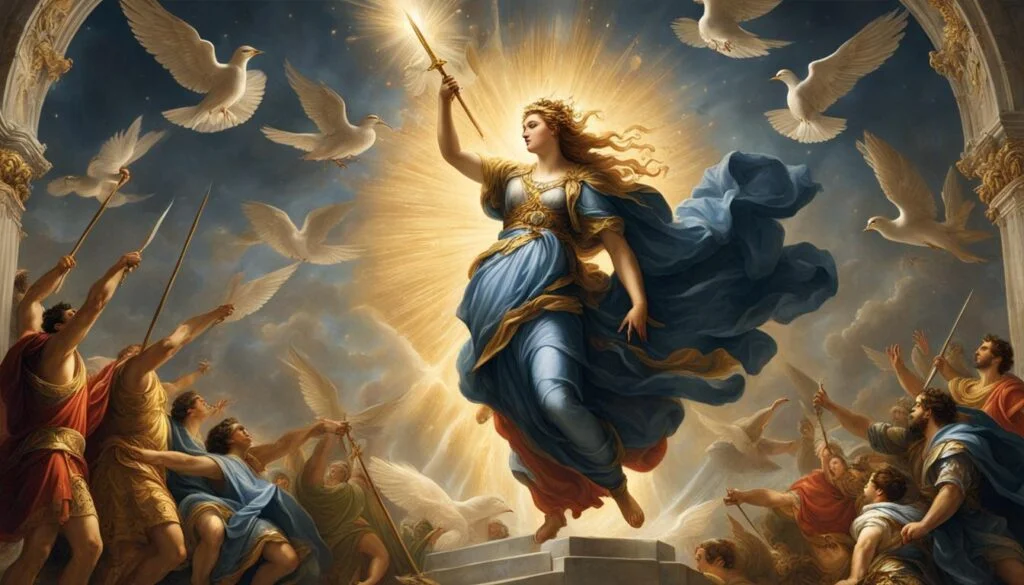
The birth of Minerva in Roman mythology is a unique tale. According to one version, Jupiter, fearing the potential rebellion of his child, swallowed the pregnant Titan goddess Metis, who was carrying Minerva. Metis remained alive within Jupiter’s body and eventually gave birth to Minerva, who emerged fully grown and dressed in armor. In another version, Minerva was born from Jupiter’s forehead after he requested the help of Vulcan, the god of metalworking, to split his head open.
Minerva’s Family
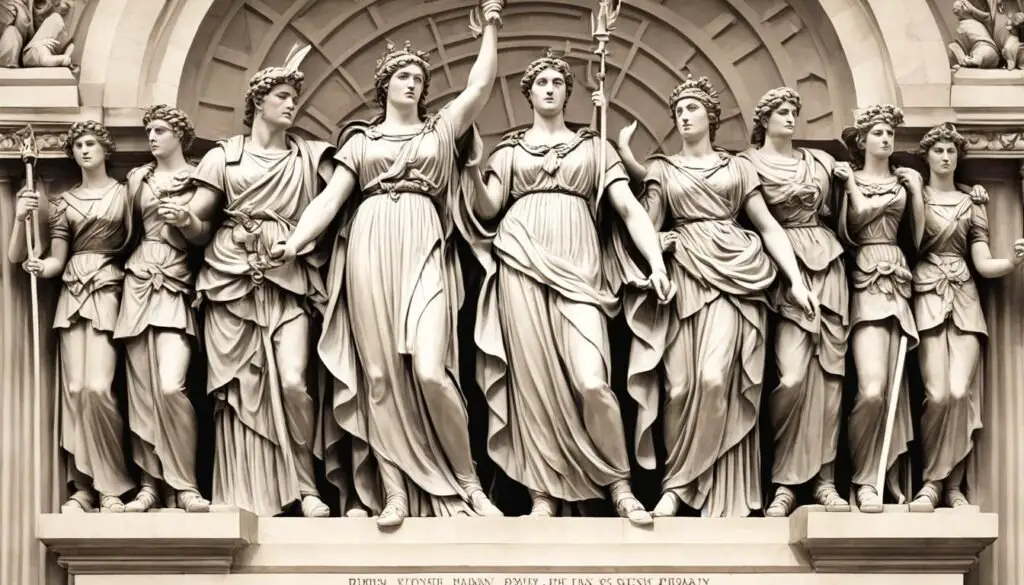
Minerva, as the daughter of Jupiter, belonged to a distinguished family that played prominent roles in Roman mythology. Among her many relatives were several notable individuals who held important positions in Roman society.
- Vulcan: Known as the god of the forge, Vulcan was Minerva’s half-brother. He had incredible skill in metalworking and was revered for his ability to craft powerful weapons and armor.
- Mars: As the god of war, Mars was Minerva’s half-brother and a powerful deity associated with conflict, violence, and military strategy. Together, Minerva and Mars represented the balance between wisdom and strength, essential qualities in warfare.
- Venus: Minerva’s half-sister, Venus, had a different domain altogether. She was the goddess of love, beauty, and fertility, and was known for her captivating charm and allure.
In addition to these siblings, Minerva had various other relatives, each with their own unique roles and domains in Roman mythology. Their collective influence and significance shaped the ancient Roman pantheon.
Minerva’s Tales and Myths
In Roman mythology, Minerva played a significant role in numerous tales and myths, showcasing her diverse abilities and involvement in various aspects of Roman culture and society.
One of the most well-known myths featuring Minerva is the story of Arachne. Arachne, a mortal weaver, challenged Minerva to a weaving competition. Despite Arachne’s impressive skills, Minerva turned her into a spider as punishment for her arrogance and disrespect.
Minerva also had a connection to the founding of Rome through her interactions with Aeneas, the legendary Trojan hero. In some versions of the myth, Minerva guided and protected Aeneas on his journey to establish the city of Rome, emphasizing her role as a guardian and patroness of the city.
Additionally, Minerva played a part in the transformation of the priestess Medusa into a monster. When Medusa boasted about her beauty, Minerva transformed her snake-like hair and turned anyone who looked at her into stone. This myth exemplifies Minerva’s power and ability to assert her dominance.
Minerva’s influence also extended to the origin of Pegasus, the famous flying horse. According to some myths, Pegasus emerged from the neck of Medusa after Perseus beheaded her with the help of Minerva. This association highlights Minerva’s involvement in the creation and emergence of legendary creatures.
Overall, Minerva’s tales and myths depict her as a powerful and influential goddess in Roman mythology, showcasing her involvement in various events and interactions with other prominent figures.
Worship of Minerva

Minerva, the goddess of wisdom, was highly revered and worshipped in ancient Rome. Her influence was evident in the numerous temples dedicated to her throughout the city. One of the most significant temples was located on the Aventine Hill, serving as a focal point for craftsmen and actors.
Intriguing Fact:
Did you know that the main temple dedicated to Minerva on the Aventine Hill was also known as the Minervium?
In addition to the temples, Minerva was associated with the Quinquatrus festival. This festival, held from March 19th to March 23rd, marked the beginning of the campaign season for the Roman army. It was a time to honor Minerva’s role in military strategy and seek her favor for victory in battle.
The worship of Minerva grew in prominence over time, reaching its peak during the reign of Emperor Domitian. As her importance increased, so did the number of festivals and celebrations held in her honor. These festivals served as a means for the people of ancient Rome to express their devotion and seek the wisdom and protection of Minerva.
Fun Fact:
The Quinquatrus festival was also considered a time for artisans and craftsmen to showcase their skills and seek the inspiration and guidance of Minerva in their creative endeavors.
Throughout the Roman Empire, Minerva’s temples and festivals were a testament to her influence and significance in the lives of the people. From the grand temples that stood as architectural marvels to the lively celebrations that brought communities together, Minerva’s worship was an integral part of ancient Roman culture.
Minerva’s Symbol and Representations
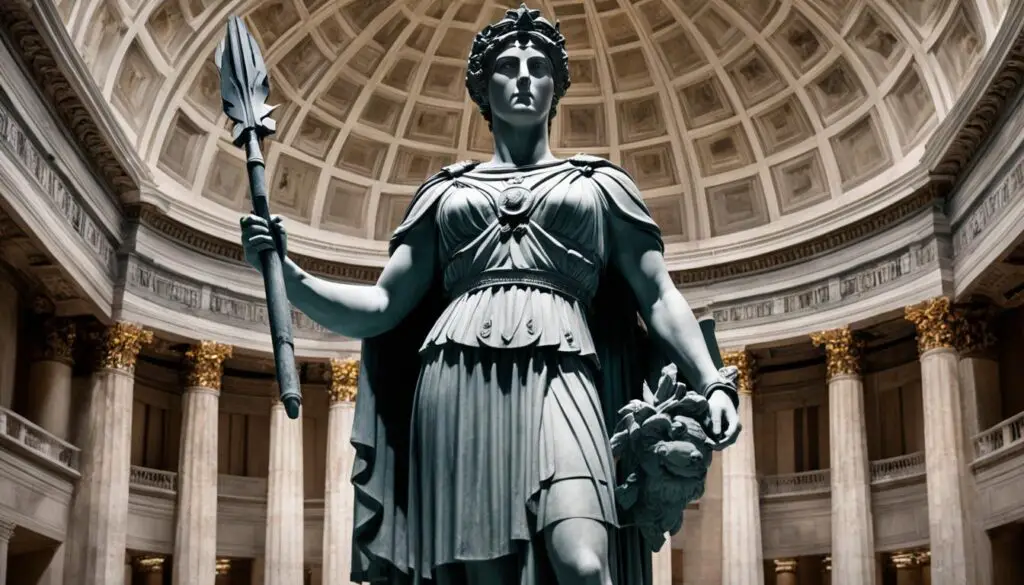
One of the most impressive representations of Minerva is the statue that now resides in the Capitoline Museums in Rome. The statue depicts Minerva as a noble and fearless warrior, wearing a Corinthian helmet, carrying a shield, and holding a spear. She is often associated with the aegis, which bears the head of Medusa. This representation showcases her role as the goddess of wisdom and victory.
Minerva’s Association with War

While Minerva initially gained prominence as the goddess of handicrafts and wisdom, her role in war expanded over time. She became highly respected as a patroness of military strategy and was revered for her exceptional tactical prowess. As Roman society recognized her expertise in warfare, Minerva’s association with war became a prominent aspect of her divine persona.
An exemplary testament to Minerva’s relationship with war is the dedication of a magnificent temple in her honor by Pompey. The temple, constructed using the spoils amassed from Pompey’s conquests in the East, stands as an enduring symbol of Minerva’s connection to military endeavors and her significant influence in matters of warfare.
Minerva’s strategic expertise and knowledge in warfare made her a revered figure among warriors and military strategists. Her guidance and wisdom were sought in times of conflict, and her reputation as a goddess of war was firmly established. Throughout the extensive Roman Empire, soldiers and leaders alike held Minerva in high esteem for her invaluable contributions to military success.
To illustrate Minerva’s association with war and her role in shaping military strategy and tactics, it is essential to explore her tales and legends. These stories provide deeper insights into the captivating realm of Roman mythology and reveal the military prowess and divine wisdom embodied by Minerva.
- The Battle of Troy: In Homer’s epic poem, the Iliad, Minerva played a vital role in the Trojan War. She guided and counseled the Greek hero, Odysseus, throughout the course of the conflict, assisting him in devising cunning strategies and outmaneuvering their Trojan adversaries.
- The Founding of Rome: According to Roman mythology, Minerva was instrumental in the founding of Rome. She appeared to Aeneas, a Trojan hero, in a dream and provided him with guidance and support. Aeneas heeded Minerva’s counsel, successfully establishing the foundations of the great city.
- The Siege of Athens: During the war between the Athenians and the Amazons, Minerva intervened on behalf of the Athenians, employing her strategic acumen to turn the tide of battle. With her assistance, Athens emerged victorious, reinforcing Minerva’s reputation as a decisive and influential war goddess.
The legends surrounding Minerva’s involvement in war serve as vivid illustrations of her esteemed status and unwavering commitment to military strategy. Her wisdom and expertise continue to inspire reverence and admiration, even in modern times.
Legends and Symbols

Minerva’s legends and symbols in Roman mythology are a testament to her power and influence. Throughout various myths and stories, Minerva’s role in shaping the world around her is evident. One notable legend is the tale of Arachne, where Minerva challenged the mortal weaver to a competition and transformed her into a spider as punishment. This myth showcases Minerva’s prowess and her ability to assert her dominance.
Minerva’s association with the founding of Rome is another significant legend. According to the myth, she played a crucial role in guiding Aeneas, the Trojan hero, as he established the city of Rome. Her guidance and wisdom contributed to the success and prosperity of the Roman Empire.
To represent her attributes and qualities, Minerva is associated with several symbols. The prominent symbol is the owl, which symbolizes wisdom and insight. Throughout history, the owl has been revered as a symbol of knowledge and enlightenment, aligning perfectly with Minerva’s role as the goddess of wisdom.
Another symbol closely associated with Minerva is the olive tree. The olive tree represents peace, fertility, and abundance. It signifies Minerva’s role in cultivating harmony and prosperity in Roman society.
Additionally, the shield with Medusa’s head is another iconic symbol associated with Minerva. This shield represents her protection and her ability to ward off enemies. The Medusa’s head on the shield acts as a deterrent to those who might challenge her, symbolizing her victory in battle.
Conclusion
Minerva, the Roman goddess of wisdom, played a significant role in the religious and cultural life of ancient Rome. Revered for her intelligence, strategy, and victory, Minerva’s presence extended into every aspect of Roman society. As a symbol of progressiveness, she challenged traditional gender roles with her expertise in both war and craftsmanship.
Minerva’s significance in Roman mythology is evident through her associations with famous myths and legends. From the myth of Arachne to her involvement in the founding of Rome, Minerva’s stories exemplify her ability to shape the world around her. Her symbols, such as the owl, olive tree, and shield with Medusa’s head, represent wisdom, victory, and protection.
While the worship of Minerva declined with the rise of Christianity, her legacy as a powerful and revered goddess remains intact in Roman mythology. Her influence on intellectual pursuits, cleverness, and military strategy continues to inspire and captivate. Minerva’s significance in Roman mythology highlights the rich tapestry of gods and goddesses that shaped the cultural and religious landscape of ancient Rome.
FAQ
What is the significance of Minerva in Roman mythology?
Minerva, the goddess of handicrafts, professions, arts, and war, played a vital role in Roman mythology. She was revered for her wisdom, intelligence, and military strategy, and her worship reached its peak during the reign of Emperor Domitian.
Who was Minerva associated with in Greek mythology?
Minerva was often identified with the Greek goddess Athena and was part of the Capitoline Triad in Rome, along with Jupiter and Juno. She shared many similarities with the Etruscan goddess Menrva and is believed to have been brought to Rome from Etruria.
How was Minerva born in Roman mythology?
According to one version, Minerva was born fully grown out of Jupiter’s head after he swallowed the pregnant Titan goddess Metis. In another version, she was born from Jupiter’s forehead after he requested the help of Vulcan, the god of metalworking, to split his head open.
Who were Minerva’s family members in Roman mythology?
Minerva was the daughter of Jupiter and had various half-siblings, including Vulcan, the god of the forge, Mars, the god of war, and Venus, the goddess of love and beauty.
What were some of Minerva’s important roles in Roman mythology?
Minerva played a role in various tales and stories in Roman mythology. She was involved in the myth of Arachne, the founding of Rome through her interactions with Aeneas, and the transformation of the priestess Medusa into a monster. She also played a part in the origin of Pegasus, the famous flying horse.
How was Minerva worshiped in ancient Rome?
Minerva had several temples throughout ancient Rome, with her main temple located on the Aventine Hill. She was associated with the Quinquatrus festival, which marked the beginning of the campaign season for the Roman army.
What are some symbols and representations of Minerva in Roman mythology?
One of the most impressive representations of Minerva is the statue that now resides in the Capitoline Museums in Rome. She is depicted as a noble and fearless warrior, wearing a Corinthian helmet, carrying a shield, and holding a spear. Her symbols include the owl, olive tree, and shield with Medusa’s head.
How was Minerva associated with war in Roman mythology?
While Minerva was initially associated with handicrafts and wisdom, her role in war grew over time. She became a patroness of military strategy and her association with war is exemplified by the erection of a temple dedicated to her by Pompey, built with spoils from his conquests in the East.
What is the significance of Minerva’s legends and symbols in Roman mythology?
Minerva’s legends and symbols showcase her power and influence. They represent her wisdom, victory, and protective nature. Her stories, from her involvement in the myth of Arachne to her association with the founding of Rome, highlight her ability to shape the world around her.
What is the significance of Minerva in Roman mythology?
Minerva, the Roman goddess of wisdom, symbolized intelligence, strategy, and victory. She played a vital role in the religious and cultural life of ancient Rome and her legacy as a powerful and revered goddess remains significant in Roman mythology.


